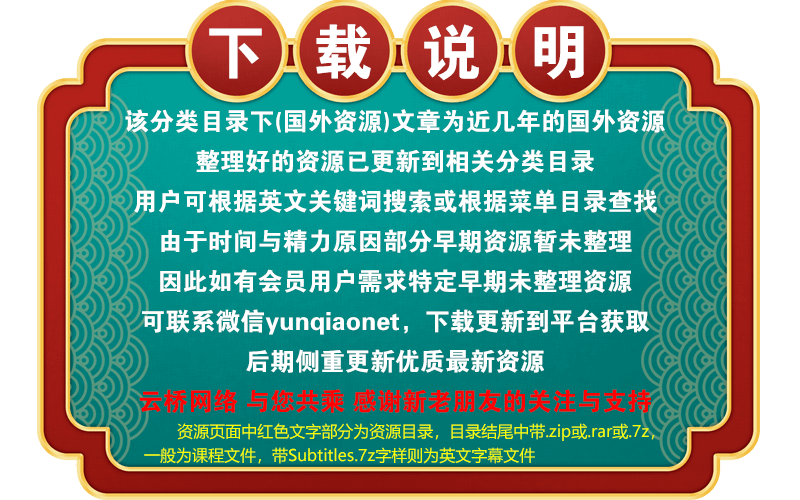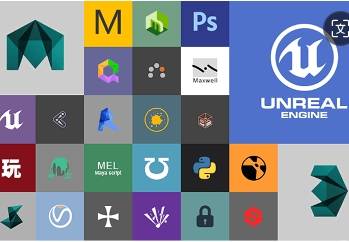Release date:2021
Author:Deke McClelland
Skill level:Beginner
Language:English
Exercise files:Yes
Learn how to use Adobe Illustrator 2021 in the first of three comprehensive training courses by industry pro Deke McClelland. Deke demonstrates how to work with artboards; how to draw with the Pencil, Curvature, and Pen tools; and how to organize color with swatches. Deke also covers drawing shapes, adjusting strokes, formatting text with variable fonts, painting freeform artwork with or without a tablet, and more.
001 Welcome to One-on-One 002 Previously on Illustrator One-on-One 003 Auto-tracing in Illustrator 004 Embedding an image by opening it 005 Linking an image by placing it 006 Auto-tracing and resolution 007 Upsample in Photoshop for better results 008 Adjusting the Threshold value 009 The advanced tracing options 010 Expanding and simplifying traced paths 011 Scaling your vector-based tracing 012 Tracing lines with uniform strokes 013 Tracing both strokes and color fills 014 The world of complex path interactions 015 Introducing the four shape modes 016 Building dynamic compound shapes 017 Exclude vs Compound Path 018 Mixing and matching shape modes 019 Adding paths to a compound shape 020 The six static Pathfinder operations 021 Working with unfilled and open paths 022 Additional Pathfinder options 023 Repeating the last Pathfinder operation 024 The legend that is the Layers panel 025 Hiding, showing, and creating layers 026 Moving and copy objects between layers 027 Lock, isolate, and preview a layer 028 Selectively unlocking on canvas 029 Adjusting the stacking order 030 Expanding the contents of a layer 031 Naming and arranging objects 032 Containers – Compound paths vs groups 033 Targeting and formatting a group 034 Targeting an entire layer 035 Its like a Layers panel for fills and strokes 036 Assigning multiple fills and strokes 037 Transforming fills and strokes 038 Clearing and duplicating appearances 039 Creating a transform sequence 040 Appearance panel tricks 041 Applying appearances to editable type 042 Assigning patterns to fills and strokes 043 Turning hexagons into honeycomb 044 Stacking attributes and effects 045 Building up depth with offset strokes 046 Drop Shadow and Gaussian Blur 047 The benefits of static transformations 048 Introducing the Scale tool 049 Setting the transformation origin 050 Global Edit 051 Introducing the Rotate tool 052 Creating transformation guides 053 Using the Scale tool to create primitives 054 Uniting and rotating the primitives 055 Introducing the Shear tool 056 Skewing one path to match another 057 Power-duplicating the petals of the star logo 058 Offset Path – A different way to scale 059 Adding skewed gradient shadows 060 Transforming partial path outlines 061 Using the Reflect tool 062 Using the Reshape tool 063 The Transform Each command 064 How alignment and distribution work 065 Snapping and Smart Guides 066 Aligning a group to the artboard 067 Distributing objects across the artboard 068 Aligning to a fixed key object 069 Distributing by a specified amount of space 070 Using the Align options as positioning tools 071 Adding extruded edges to your artwork 072 Aligning the backs of your extruded letters 073 Casting shadows from faux 3D objects 074 The joy of custom gradients 075 Assigning and modifying a gradient 076 Lifting a color from a pixel-based image 077 Designing and saving linear gradients 078 Using the Gradient tool and Annotator 079 Working with radial gradients 080 Offsetting the center of a radial gradient 081 Combining gradients with clipping masks 082 Adjusting the opacity of gradients 083 Working with freeform gradients 084 Painting lines of freeform gradients 085 Painting gradient hair 086 Assigning a gradient to an entire layer 087 Assigning gradient strokes 088 Combining multiple gradient fills 089 Exporting your emoji to use with a device 090 Illustrators oldest dynamic functions 091 Creating a dynamic object blend 092 Redirecting a blend by editing its spine 093 Creating a custom shape gradient 094 Adding texture to your custom gradient 095 Meet the Reverse Front to Back command 096 Creating a clipping mask 097 Masking the contents of an entire layer 098 Fixing problems with the Blend tool 099 Aligning your intervals to the spine 100 Moving objects into a clipping mask 101 Blending between groups 102 Blending the colors of sequential paths 103 Coloring overlapping areas 104 Introducing Live Paint 105 Modifying Live Paint strokes 106 Using the Live Paint Selection tool 107 Coloring traced or freeform line art 108 Automatic gap detection 109 Merging live paint objects 110 Filling a region with a gradient 111 Introducing the false Mobius strip 112 Drawing a ribbon using an object blend 113 Violating all laws of stacking order 114 Sneak peek – Recolor Artwork 115 Shading a Live Paint object with gradients 116 Tailoring your gradients to fit your art 117 Introducing the pixel-based image 118 Placing a photograph into your artwork 119 Working with linked images 120 Scaling and cropping with the bounding box 121 Drawing a border around an image 122 Cropping an image using a clipping mask 123 Using the Mask and Crop Image buttons 124 Creating dynamic crop marks around your art 125 Placing an image with transparency 126 Placing a photograph into editable type 127 Adding stroke effects behind photo type 128 Packaging all linked images and fonts 129 Generating colors using harmony rules 130 Introducing the Color Guide panel 131 The color models – RGB, CMKY, and Lab 132 The 23 color harmony rules 133 Mixing and matching color harmonies 134 Using a color group as a harmony rule 135 Loading a predefined swatch library 136 Introducing the Edit Colors dialog box 137 Mastering the Edit Colors controls 138 Constraining colors to a swatch library 139 Sharing swatches between documents 140 Making your swatch libraries persistent 141 Changing lots of colors all at once 142 Introducing the Recolor Artwork command 143 Editing colors with the Lab Color Wheel 144 Locating specific colors in your artwork 145 Recoloring artwork using a color group 146 Reducing your art to three spot colors 147 The five color reduction methods 148 Recoloring all varieties of gradients 149 Recoloring a repeating tile pattern 150 My favorite features in all of Illustrator 151 Applying and expanding a dynamic effect 152 Drawing an orthogonal cube 153 Creating a dynamic cube of cubes 154 Busting up and coloring the cubes 155 Adding glows and shadows with Outer Glow 156 Targeting the contents of a group 157 Clipping effects inside objects 158 Creating flower petals with Pucker & Bloat 159 Scale, rotate, and duplicate in one operation 160 Document Raster Effects settings 161 Alternating the colors of repeated objects 162 Creating an origami effect with Zig Zag 163 Duplicating effects between fills 164 Swapping out colors in dynamic art 165 Dynamic repeats – Mirror and Radial 166 Saving attributes and effects 167 Introducing the Graphic Styles panel 168 Creating your own graphic style 169 Assigning a style to an entire layer 170 Updating graphic styles 171 Experiment freely without penalty 172 Combining multiple styles 173 Utterly mastering graphic styles 174 Refining a Pucker & Bloat effect 175 Illustrators elaborate Print Engine 176 Printing to colored paper stock 177 Adding a bleed for borderless printing 178 The Separations Preview panel 179 Working with Pantone spot colors 180 Troubleshooting and overprinting 181 Introducing the Print command 182 Adding trim and printers marks 183 Exporting color separations 184 Until we next meet
[LimkedIn] Illustrator 2021 One-on-One Fundamentals With Deke McClelland.7z [LimkedIn] Illustrator 2021 One-on-One Fundamentals With Deke McClelland_Subtitles.7z
 Channel and
Channel and  Group
Group
1、登录后,打赏30元成为VIP会员,全站资源免费获取!
2、资源默认为百度网盘链接,请用浏览器打开输入提取码不要有多余空格,如无法获取 请联系微信 yunqiaonet 补发。
3、分卷压缩包资源 需全部下载后解压第一个压缩包即可,下载过程不要强制中断 建议用winrar解压或360解压缩软件解压!
4、云桥网络平台所发布资源仅供用户自学自用,用户需以学习为目的,按需下载,严禁批量采集搬运共享资源等行为,望知悉!!!
5、云桥网络-CG数字艺术学习与资源分享平台,感谢您的赞赏与支持!平台所收取打赏费用仅作为平台服务器租赁及人员维护资金 费用不为素材本身费用,望理解知悉!



评论(0)